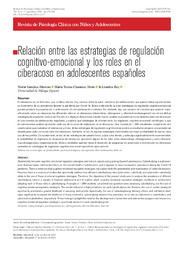Título :
Relación entre las estrategias de regulación cognitivo-emocional y los roles en el ciberacoso en adolescentes españoles |
Autor :
Sánchez-Moreno, Víctor
Chamizo-Nieto, María Teresa
Rey, Lourdes |
Editor :
Universidad Miguel Hérnández de Elche |
Departamento:
Departamentos de la UMH::Psicología de la Salud |
Fecha de publicación:
2025 |
URI :
https://hdl.handle.net/11000/36744 |
Resumen :
El ciberacoso es un fenómeno que conlleva efectos muy nocivos sobre la salud mental de los adolescentes, que parece haber experimentado un incremento de su prevalencia durante la pandemia por Covid-19. Existe evidencia de que las estrategias de regulación cognitivo-emocional pueden predecir la perpetración o victimización de comportamientos violentos. No obstante, hay una escasez de estudios que analicen específicamente cómo se relacionan los diferentes roles en el ciberacoso (cibervíctima, ciberagresor y cibervíctima-ciberagresor) con el uso dichas estrategias de regulación emocional. Por ello, los objetivos del presente estudio fueron: analizar la prevalencia de los distintos roles del ciberacoso en una muestra de adolescentes españoles; y explorar qué estrategias de afrontamiento de regulación cognitivo-emocional contribuyen a que los adolescentes acaben ejerciendo cada uno de los roles de implicación en el ciberacoso. Una muestra de 1,389 estudiantes cumplimentó dos cuestionarios que evaluaban el ciberacoso y el uso de las estrategias de regulación cognitivo-emocional. Los resultados arrojaron una prevalencia elevada para cada uno de los roles del ciberacoso. Asimismo, el uso de algunas estrategias determinaba una mayor probabilidad de ejercer cada uno de los perfiles. Concretamente, el uso de las estrategias de catastrofismo, culpar a los demás y autoculpa significativamente incrementaban la probabilidad de implicarse en situaciones de ciberacoso ejerciendo alguno de los roles como cibervíctimas, ciberagresores y como cibervíctimas-ciberagresores, respectivamente. Dichos resultados apuntan hacia el desarrollo de programas de prevención e intervención en ciberacoso centrados en estrategias de regulación cognitivo-emocional específicos para cada rol.
Relationship between cognitive-emotional regulation strategies and roles in cyberbullying among Spanish adolescents. Cyberbullying is a phenomenon that has highly detrimental effects on the mental health of adolescents, and it appears to have increased in prevalence during the Covid-19 pandemic. There is evidence that cognitive-emotional regulation strategies may explain both the perpetration and victimisation of violent behaviours. However, there is a scarcity of studies that specifically address how different cyberbullying roles (cybervictim, cyberbully and cybervictim-cyberbully) relate to the use of these emotional regulation strategies. Therefore, the objectives of the present study were to analyse the prevalence of different cyberbullying roles in a sample of Spanish adolescents and to explore which cognitive-emotional regulation strategies contribute to adolescents adopting each of these roles in cyberbullying. A sample of 1,389 students completed two questionnaires assessing cyberbullying and the use of cognitive-emotional regulation strategies. The results indicated a high prevalence for each cyberbullying role. Besides, the use of certain strategies significantly predicted a greater likelihood of adopting each profile. Specifically, the use of catastrophising, blaming others, and self-blame strategies significantly increased the likelihood of being involved in cyberbullying situations by exercising some role as cybervictims, cyberbullies, and cybervictim-cyberbullies, respectively. These findings highlight the need for the development of prevention and intervention programmes focused on cognitive-emotional regulation strategies, specifically tailored to each cyberbullying role.
|
Palabras clave/Materias:
estrategias de afrontamiento
factores psicológicos
ciberagresión
cibervictimización
doble rol |
Área de conocimiento :
CDU: Filosofía y psicología: Psicología |
Tipo de documento :
info:eu-repo/semantics/article |
Derechos de acceso:
info:eu-repo/semantics/openAccess
Attribution-NonCommercial-NoDerivatives 4.0 Internacional |
DOI :
10.21134/rpcna.2025.12.3.4 |
Publicado en:
Revista de Psicología Clínica con Niños y Adolescentes Vol. 12 nº. 3- septiembre 2025 - pp 178-186 |
Aparece en las colecciones:
Revista de Psicología Clínica con Niños y Adolescentes (RPCNA) Vol. 12, Nº 3 (Sep. 2025)
|
 La licencia se describe como: Atribución-NonComercial-NoDerivada 4.0 Internacional.
La licencia se describe como: Atribución-NonComercial-NoDerivada 4.0 Internacional.
.png)
